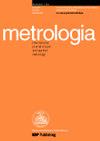A novel radiometric calibration of infrared thermometer
IF 2.4
3区 工程技术
Q2 INSTRUMENTS & INSTRUMENTATION
引用次数: 0
Abstract
Abstract A new temperature calibration scheme was proposed and implemented on the National Physical Laboratory infrared radiometer Absolute Measurements of Blackbody Emitted Radiance (AMBER) operating in the wavelength range from 9 µm to 11 µm and equipped with a cryogenically cooled mercury cadmium telluride detector. The scheme involves measurements of the relative spectral responsivity of the filter radiometer including the spectral transmittance of the window and lens. It requires calibration at two reference temperatures, but does not involve measurement of the zero-radiance signal. The scheme uses a Ga-point blackbody as one reference point, and a variable temperature blackbody source at close to −30 °C with its temperature measured with a standard platinum resistance thermometer as the other. The measured temperature was compared using the variable temperature blackbody as the source against the temperature measured by the standard platinum resistance thermometer and agreement within the uncertainties was confirmed at intermediate temperatures. The scheme has the advantage that it makes full use of the small uncertainty realised by the fixed-point blackbody. The scheme was successfully implemented in an international comparison of sea surface temperature measuring radiometers where AMBER served to provide the reference.一种新的红外测温仪辐射定标方法
摘要提出了一种新的温度校准方案,并在国家物理实验室黑体发射辐射绝对测量(AMBER)红外辐射计上实施,该辐射计工作波长范围为9µm ~ 11µm,配备了低温冷却碲化汞镉探测器。该方案包括测量滤光辐射计的相对光谱响应度,包括窗口和透镜的光谱透射率。它需要在两个参考温度下进行校准,但不涉及零辐射信号的测量。该方案使用ga点黑体作为一个参考点,以及接近- 30°C的变温黑体源,其温度用标准铂电阻温度计测量作为另一个参考点。将变温黑体作为源测得的温度与标准铂电阻温度计测得的温度进行了比较,并在中间温度下确认了不确定度内的一致性。该方案的优点是充分利用了定点黑体的小不确定性。该方案已成功地在一个国际比较的海面温度测量辐射计中实施,其中AMBER提供了参考。
本文章由计算机程序翻译,如有差异,请以英文原文为准。
求助全文
约1分钟内获得全文
求助全文
来源期刊

Metrologia
工程技术-物理:应用
CiteScore
2.80
自引率
25.00%
发文量
137
审稿时长
12 months
期刊介绍:
Published 6 times per year, Metrologia covers the fundamentals of measurements, particularly those dealing with the seven base units of the International System of Units (metre, kilogram, second, ampere, kelvin, candela, mole) or proposals to replace them.
The journal also publishes papers that contribute to the solution of difficult measurement problems and improve the accuracy of derived units and constants that are of fundamental importance to physics.
In addition to regular papers, the journal publishes review articles, issues devoted to single topics of timely interest and occasional conference proceedings. Letters to the Editor and Short Communications (generally three pages or less) are also considered.
 求助内容:
求助内容: 应助结果提醒方式:
应助结果提醒方式:


